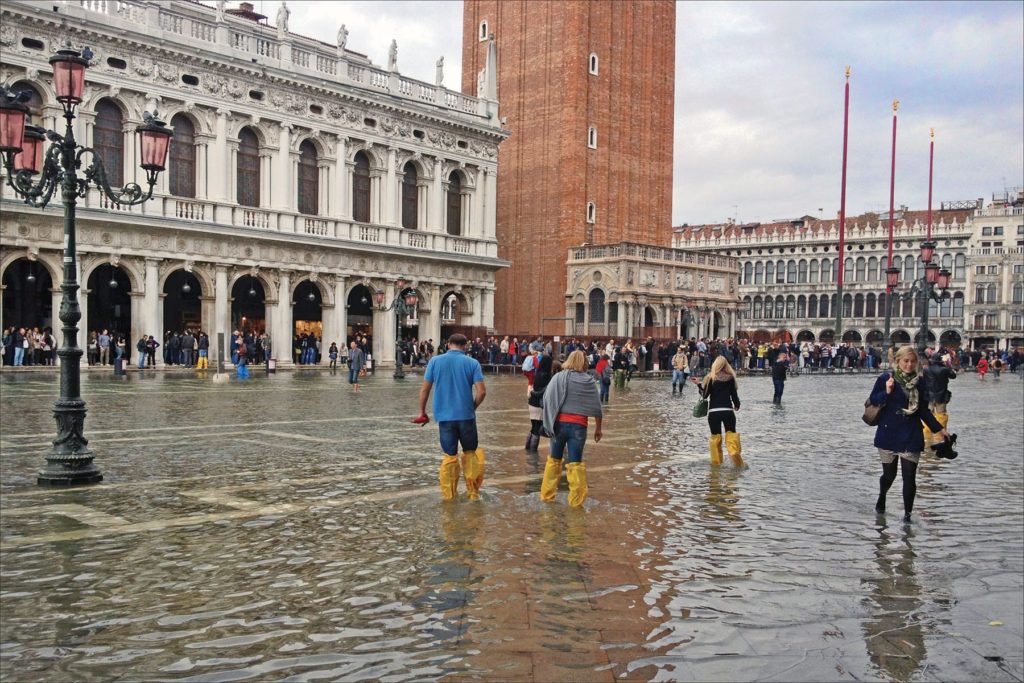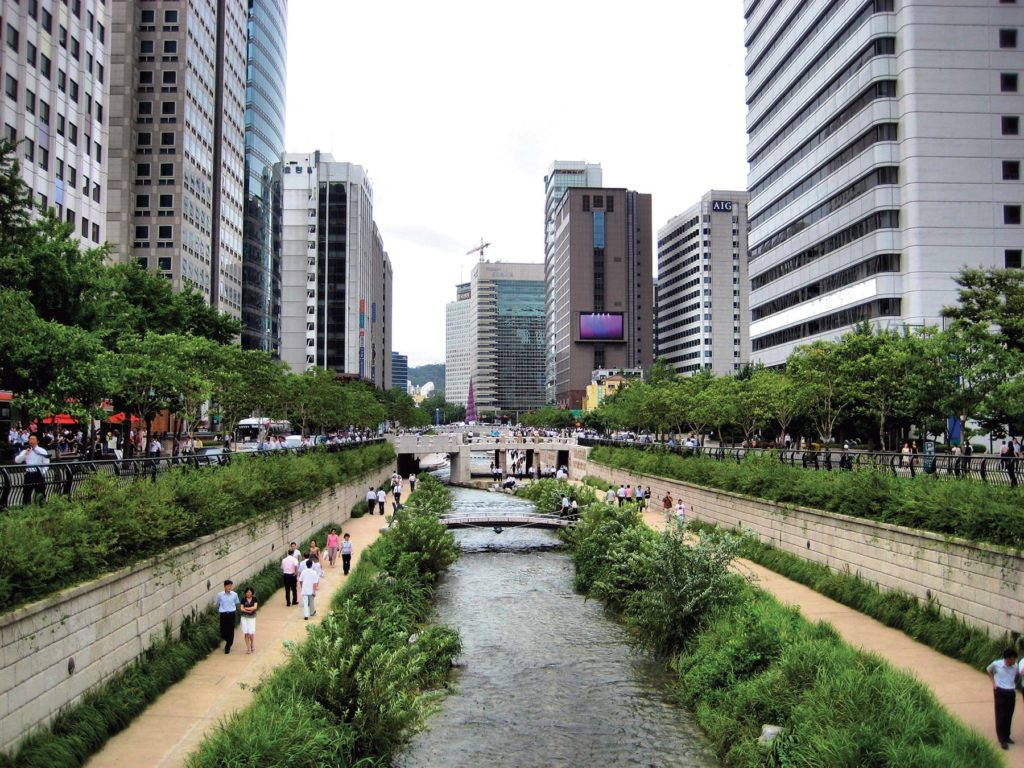The City of the Future Is a ‘Water-Sensitive’ City
Why is water key from a local perspective?
Water is essential wherever people decide to settle. It is indispensable for maintaining all kind of life, be it flora, fauna or humankind. It is one of the most precious resources on earth, but it is not available ubiquitously. Its unique value is best felt where its presence is rare – the old proverb still rings true, you never miss the water until the well runs dry.
In an average European city of today, all inhabitants expect an unlimited supply of clean water coming out of their taps: for drinking, washing, cleaning, and enjoying it in all its dimensions. A regular supply of water is, of course, also needed for urban services such as maintaining parks and other green spaces, as well as for industrial and energy production. With climate change taking its toll more and more tangibly, a city that can’t guarantee a regular water supply any more will become less attractive to new companies looking to set up business. The same goes for a city that is frequently exposed to heavy rainfalls, but badly equipped to manage them without major damage happening to people, properties and infrastructure.
Managing water poorly at the local level severely affects a city’s quality of life, and its opportunities for developing sustainably across all sectors and layers of the local society.

What are the main water challenges local governments are facing?
One major issue is that a substantial proportion of the urban water infrastructure across Europe is coming to the end of its lifetime, and major investments for its rehabilitation or renewal are required. Decisions have to be long-sighted, while challenges are becoming more and more complex and for some of them no proper solutions even exist yet.
These challenges affect both water quality and quantity. In the European Union, we have an ambitious and globally acclaimed water policy, in particular the Water Framework Directive. But implementation is still lagging behind. Only approximately 40 percent of European surface water, for example, has been found to be in good chemical and ecological status.
Last year’s State of Water Report by the European Environment Agency found that waters in Europe are still exposed to significant pressures. These come from both diffuse pollution, such as excessive inputs of nitrate in agricultural production, as well as from point-source pollution, for example from industrial production.
Water quality is also increasingly affected by emerging pollutants – especially micro-plastics and pharmaceuticals, such as antibiotics. And mercury still plays a major role, at least in some parts of Europe. With the water cycle operating at a catchment scale, all of these substances arrive eventually in the urban water network.
In addition to water quality issues, climate change has caused both drought and flooding events to become more extreme and more frequent.
In particular, Southern Europe is suffering from summers that are becoming hotter and drier, but central and Northern parts of Europe are not spared. In fact, the areas most affected by drought during the prolonged heatwave in summer 2018, were mostly located in central and northern Europe.
On the other hand, many cities have experienced devastating floods in recent years, which are far beyond the scope of extreme storm water events that were to be expected from time to time in the last century or two.
Adding rising sea levels to the list, coastal cities are especially vulnerable. Just recently more than 80 percent of the city of Venice (Italy) was flooded after an unfortunate combination of high spring tides and a meteorological storm surge. The highest water levels in more than 50 years caused hundreds of millions of euro worth of damage.
How are cities and towns around Europe dealing with all these challenges?
The solutions are just as wide-ranging as the challenges. Innovative technologies, including digital tools, are indispensable, but more and more decisionmakers also recognise the benefits of green-blue infrastructures and better urban planning.
The urban water cycle can only be managed effectively when understanding all its different components in a holistic manner: from water supply to water demand, from water consumption to wastewater treatment, from periods of too much to periods of too little water. Integrated approaches that also recognize the strong interlinkages with other sectors – such as energy and environmental management – turn out to be more efficient than managing water in isolation.
Citizen awareness is also key. Citizens can provide a significant contribution to saving water when supplies are going down in times of drought. Citizens are also instrumental in helping prevent flooding, for example by offering their share of unsealing the ground of private properties and disconnecting stormwater from wastewater infrastructure. Local governments are well placed to spread latest information and also motivate ‘water-wise’ behaviour through financial or other incentives.

What is important for urban water systems to contribute to mitigating or adapting to climate change?
Conventional wastewater utilities are significant energy consumers and can therefore substantially contribute to CO2 emissions. Luckily, numerous new technologies have arrived on the market that can turn wastewater utilities from energy consumers into energy producers, for example by using the waste heat from the treatment process as a renewable energy.
The potential of water management in adaptation is even higher, since most climate change impacts have an immediate effect on the water cycle. Crucial in this context is that water managers can’t do it alone. Urban planners, for instance, have to keep in mind where stormwater is gathering and in which direction it is flowing in the case of extreme flooding events and ensure that it can be retained in selected spaces, or easily infiltrated into the ground. Sealed surfaces have to be replaced by porous, ideally natural ones. Green urban landscapes can include swales and retention areas that are at the same time pleasant to the eye, offer a multitude of leisure, health and aesthetic benefits and also serve the urban biodiversity. Water features, such as small open water channels, fountains or basins are effective means to counteract urban heat island effects.
What water related projects is ICLEI currently working on?
Excitingly, ICLEI, alongside The Nature Conservancy, and Ecologic Institute, just recently launched a new report titled: ‘Investing in Nature for European Water Security’. In the report, we draw on extensive consultation, existing experiences, and case study research to provide a strategic vision for scaling-up Nature Based Solutions NBS for water security in Europe, including overviewing the role of NBS and examining investments in these solutions.
Cities such as Paris (France), Munich or Augsburg (Germany), for example, have provided incentives to farmers in areas where their water supplies come from in order to encourage them to apply more organic farming practices. In turn, money is saved locally through less requirements for treating water to make it fit for human consumption. The publication contains several other examples providing evidence that it can be economically sensible to choose green – or hybrid – over grey solutions both for tackling water quantity as well as quality issues.
Let me also mention the Connecting Nature project, which is funded through the European Commission’s Horizon 2020 programme. A major topic explored through the project is how water and climate resilience can be achieved through nature-based solutions.
Through the project, the City of Glasgow (United Kingdom), for example, has implemented a comprehensive stormwater management system comprised of permeable paving, swales, rain gardens, and balancing ponds in the Athlete’s Village, a legacy of the 2014 Commonwealth Games. Or to pick a completely different example, the City of Poznań (Poland) has made great strides in re-connecting its citizens to the river Warta, by creating municipal beaches and opportunities for numerous other leisure activities. Doing so they also aim to provide thermal comfort zones for the inhabitants suffering from the urban heat islands during the summer when the heat reaches its peak.
Also financed by the European Commission is the INCOVER project, which ended earlier this year. The project investigated technologies for the recovery of resources from wastewater. Local governments striving to become a circular city should pay close attention to the potential of such kinds of technologies. The ones developed by INCOVER make it possible, for example, to extract nutrients from wastewater for the production of bio-fertiliser, or to generate PHA, a feedstock for bio-plastics.

How would you describe your ideal city of the future and how would it deal with water?
The city of the future is a ‘water-sensitive’ city. The water cycle – both its natural as well as its man-made dimension – is fully incorporated into the urban design. Water is visible in the city’s landscape. Water users are conscious about its value and the costs of polluting it. And people have ample opportunity to enjoy its benefits without disturbing its ecological balance.
Water is handled as a part of the city’s metabolism. A multitude of valuable materials are being extracted by the local wastewater utility, and the energy and other products contribute to the local economy. Reclaimed water is returned to urban uses such as for
irrigating public spaces and cleaning streets or municipal facilities.
Water is a top priority and water managers work closely with their colleagues from other departments to ensure all water services run smoothly. They work to ensure that a mutually beneficial relationship with the public around water is in place and, also that the city is ready to stand against the vagaries of climate change!